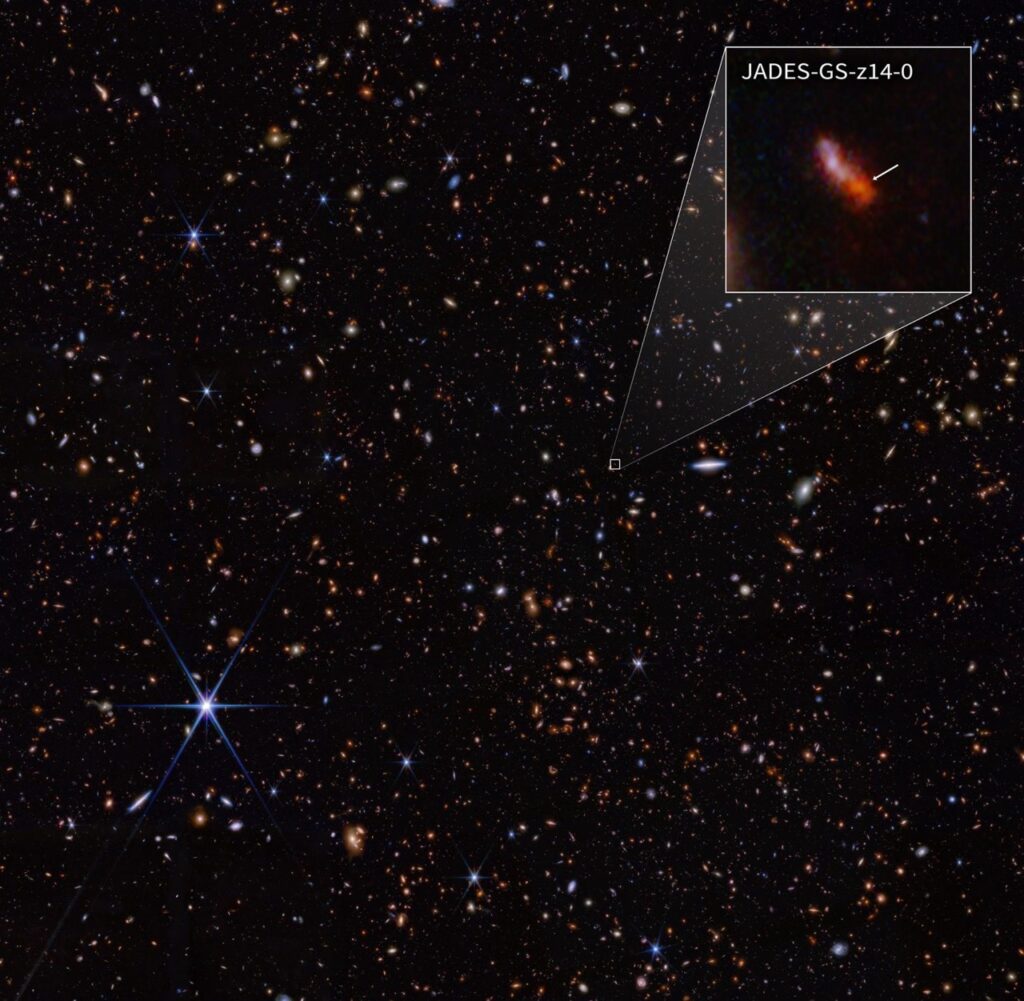Webb Makes Groundbreaking Discovery of Farthest Known Galaxy – A Major Milestone in Extragalactic Exploration
Researchers utilizing NASA’s James Webb Space Telescope have uncovered galaxies that push the boundaries of cosmic exploration, dating back to a mere 300 million years post-Big Bang, marking a significant leap in our comprehension of the universe’s infancy.

An international consortium of astronomers has unveiled the discovery of two of the earliest and most distant galaxies to date, originating just 300 million years after the Big Bang. This notable breakthrough, facilitated by NASA’s James Webb Space Telescope (JWST), represents a pivotal juncture in our quest to unravel the mysteries of the early cosmos. The identification of these galaxies was spearheaded by the JWST Advanced Deep Extragalactic Survey (JADES) team, co-headed by Brant Robertson, an astronomer from UC Santa Cruz.
Robertson remarked, “This finding is unprecedented and is poised to be recognized as the most consequential extragalactic revelation achieved with JWST thus far.” Serving as the lead author on the initial of three papers delineating various facets of this discovery, Robertson’s team highlighted the transformative impact of new JWST observations on our comprehension of the remote universe. With the confirmation of high-redshift galaxy populations existing less than 300 million years post-Big Bang, our temporal understanding has extended by 40% within the initial eighteen months of JWST operations.
The term “redshift” denotes the phenomenon induced by the universe’s expansion, causing the wavelength of light emanating from distant galaxies to elongate during its journey. In these newly unearthed galaxies, this effect is pronounced, stretching light by a factor of 15 and shifting even ultraviolet emissions to infrared wavelengths detectable solely by JWST.
Pursuing Ancient Galaxies
Contemporary cosmological theories posit that galaxies evolve within specialized regions where gravitational forces coalesce cosmic gases and dark matter into dense formations known as “halos.” These halos undergo rapid transformations during the universe’s early epochs, amalgamating into increasingly massive conglomerates of matter. The urgency to uncover even earlier galaxies stems from the incremental nature of this evolution: each discovery propels our gaze further back in time, unveiling galaxies in progressively less mature stages, thus rendering brighter galaxies increasingly distinctive and anomalous.
Located proximate to the Hubble Ultra Deep Field, the two recently identified galaxies have been conclusively confirmed through spectroscopic analysis. Adhering to the collaboration’s customary nomenclature, these galaxies are now designated as JADES-GS-z14-0 and JADES-GS-z14-1, with the former being the more distant entity.
In addition to establishing a new distance record, JADES-GS-z14-0 stands out for its considerable size and luminosity. JWST measurements indicate a diameter exceeding 1,600 light-years. While many luminous galaxies primarily derive their luminosity from gas accretion onto supermassive black holes, resulting in quasar activity, the team’s analysis suggests that the abundant light emitted by JADES-GS-z14-0 originates from nascent stars.
Unearthing Hidden Treasures
Nevertheless, the colossal galaxy posed a conundrum for the JADES team upon its initial detection over a year ago, as its proximity to a foreground galaxy cast doubt on whether they were distinct entities. However, in October 2023, the JADES team conducted extensive imaging—spanning five full days with the JWST Near-Infrared Camera focusing on a single field—to establish the “JADES Origins Field.” Employing filters tailored to isolate early galaxies more effectively bolstered the team’s confidence in the distant nature of JADES-GS-z14-0.
Moreover, the galaxy coincided with a region subject to ultra-deep imaging using the JWST Mid-Infrared Instrument. The amalgamation of these imaging results emboldened the team to include the galaxy in the culminating observation of JADES: a 75-hour campaign dedicated to spectroscopic analysis of faint early galaxies. The spectroscopic data validated their supposition regarding JADES-GS-z14-0’s record-breaking status and affirmed the considerable distance of the fainter contender, JADES-GS-z14-1.
A New Epoch in Cosmic Endeavors
The amalgamation of high luminosity and stellar origin renders JADES-GS-z14-0 the most compelling evidence thus far for the rapid emergence of large, massive galaxies in the early universe. Robertson emphasized, “We could have detected this galaxy even if it were 10 times fainter, indicating the potential discovery of even earlier examples, possibly within the first 200 million years.” He further described the galaxy as a “gem,” hinting at the existence of additional hidden treasures within the primordial cosmos.
Robertson’s paper, titled “Earliest Galaxies in the JADES Origins Field: Luminosity Function and Cosmic Star-Formation Rate Density 300 Myr after the Big Bang,” is slated for publication in the Astrophysical Journal.


